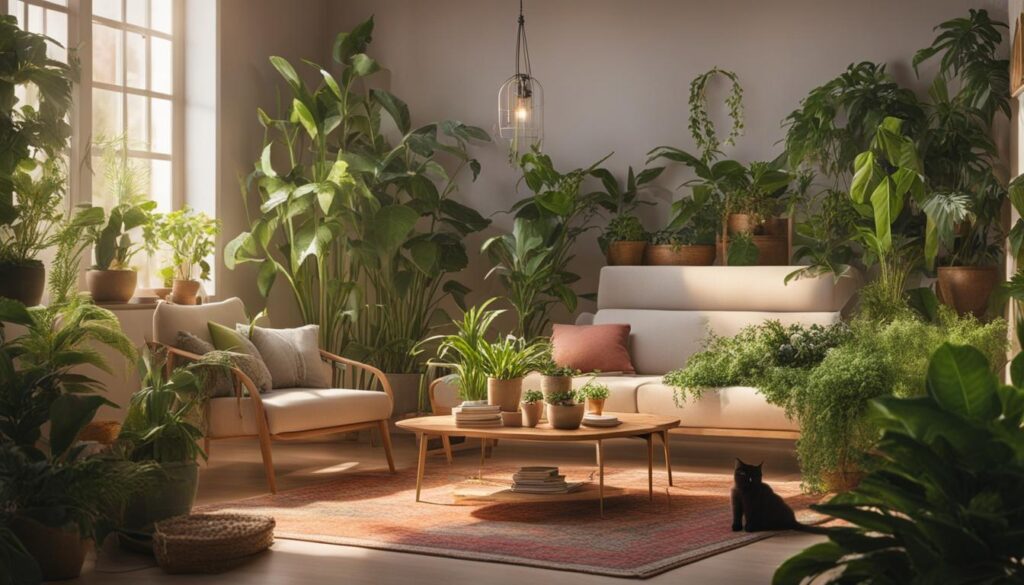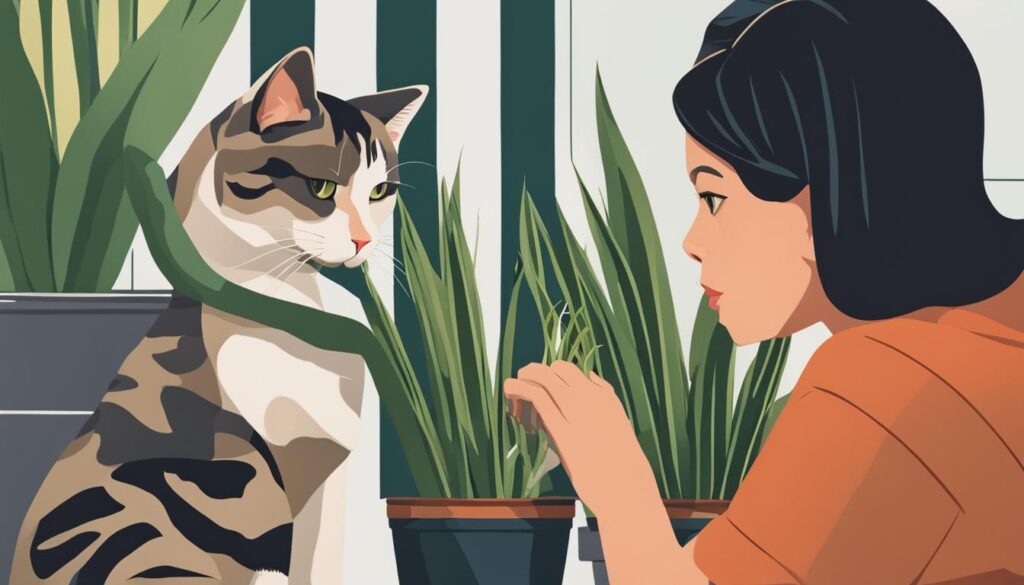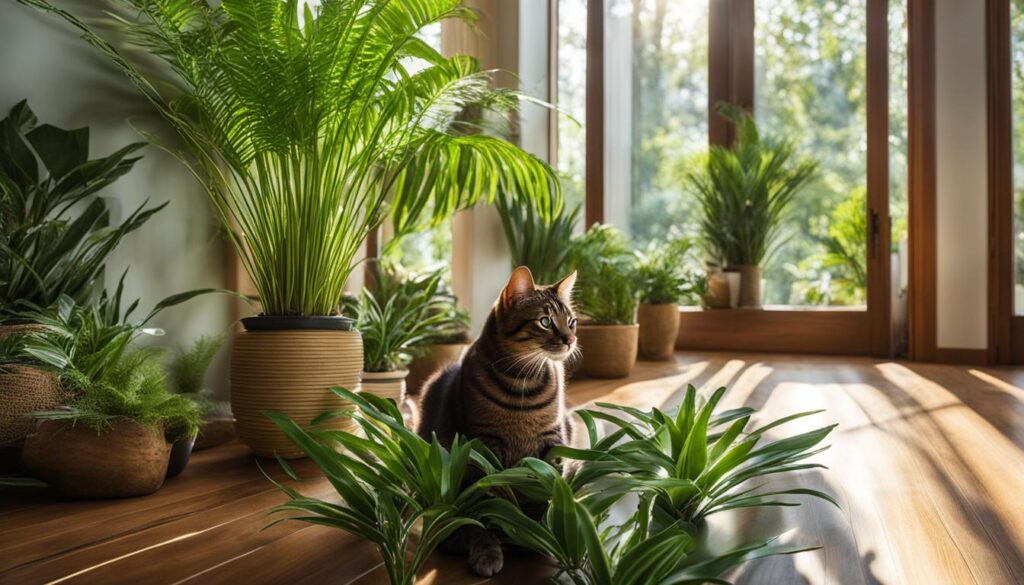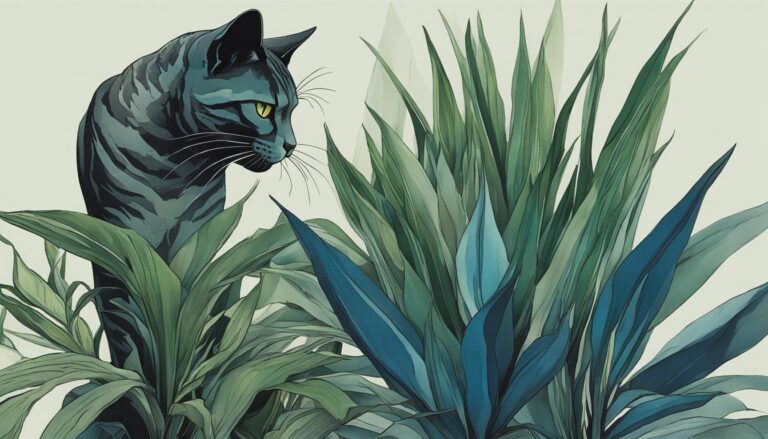If you’re a cat owner, you may have heard conflicting information about whether snake plants are toxic to cats or not. In this article, we will delve into this topic to provide you with the facts and help you understand the potential dangers of snake plants for your feline friend.
Snake plants, also known as Sansevieria trifasciata, have become popular houseplants due to their attractive appearance and low-maintenance nature. However, it’s essential to consider your pet’s safety when choosing indoor plants.
Snake plants are indeed toxic to cats. They contain a toxin called saponin, which can cause sickness in cats if ingested. It’s crucial to be aware of this potential danger and take necessary precautions to ensure your cat’s well-being.
Principales conclusiones:
- Snake plants are toxic to cats due to their saponin content.
- It’s important to be aware of potential dangers and take necessary precautions to keep your cat safe.
- Consider cat-friendly alternatives to snake plants.
- Be vigilant for symptoms of snake plant poisoning in cats and seek veterinary care if necessary.
- Creating a safe environment for your cat includes removing toxic plants and providing cat-friendly alternatives.
Why Are Snake Plants Toxic to Cats?
Snake plants, also known as Sansevieria trifasciata, are popular houseplants known for their hardiness and air-purifying properties. While they can be a great addition to any home, it’s important to be aware that snake plants are toxic to cats. Understanding why these plants are harmful to cats can help pet owners make informed choices about the safety of their feline companions.
The toxicity of snake plants to cats is primarily due to the presence of saponin, a toxic chemical compound. Saponin is found in various parts of the plant, including the leaves. When a cat chews on or ingests any part of the plant, the saponin is released and can cause poisoning. While the exact mechanism of saponin toxicity in cats is not fully understood, it is known to affect the gastrointestinal system and can lead to symptoms such as vomiting, diarrhea, and abdominal pain.
As responsible cat owners, it is essential to be proactive in preventing any potential harm to our furry friends. If you have snake plants in your home and also have cats, it’s advisable to keep the plants out of their reach. Placing them in high or inaccessible areas can help minimize the risk of ingestion. Additionally, consider providing your cats with cat-friendly alternatives, such as cat grass or catnip toys, to redirect their attention away from potentially toxic plants.
It’s worth noting that while snake plants are toxic to cats, they are generally considered safe for dogs. If you have both cats and dogs in your home, it’s important to choose plants that are safe for all your pets. Researching and selecting cat-safe houseplants can help create a pet-friendly environment that promotes the health and well-being of all your furry companions.
Symptoms of Snake Plant Poisoning in Cats
Cats are curious creatures, and their natural instinct to explore their surroundings can sometimes lead them into trouble. If you have a snake plant in your home, it’s important to be aware of the potential risks it poses to your feline friend. Snake plants, also known as Sansevieria trifasciata, contain a toxin called saponin that can be toxic to cats if ingested. As a responsible cat owner, it’s crucial to recognize the symptoms of snake plant poisoning in cats.
When a cat ingests a snake plant, they may display various symptoms depending on the amount consumed and their individual sensitivity. Common signs of snake plant poisoning in cats include nausea, vomiting, diarrhea, lethargy, loss of appetite, swollen mouth or throat, drooling, and abdominal pain. It’s essential to monitor your cat closely for any changes in their behavior or health and seek veterinary care immediately if you suspect they have been poisoned.
Table: Symptoms of Snake Plant Poisoning in Cats
| Symptom | Descripción |
|---|---|
| Nausea | Feeling of queasiness and discomfort in the stomach |
| Vómitos | Expelling of stomach contents through the mouth |
| Diarrea | Frequent loose or watery stools |
| Letargo | Excessive tiredness and lack of energy |
| Pérdida de apetito | Decreased interest in food and refusal to eat |
| Swollen mouth or throat | Inflammation and swelling in the oral cavity or throat |
| Babeando | Excessive salivation or dribbling of saliva |
| Dolor abdominal | Discomfort or cramping in the abdomen |
Remember that not all cats will exhibit the same symptoms, and the severity of the symptoms can vary. It’s always better to err on the side of caution and consult a veterinarian if you suspect your cat has been exposed to snake plant poisoning. Prompt veterinary care is crucial to ensure the well-being and recovery of your beloved feline companion.

Treating Snake Plant Toxicity in Cats
Snake plant toxicity in cats can be a cause for concern, but with proper treatment, the negative effects can be minimized. If you suspect that your cat has ingested a snake plant and is showing symptoms of poisoning, it is essential to consult a veterinarian for evaluation and guidance.
The treatment for snake plant toxicity will vary depending on the severity of the symptoms and the individual cat’s condition. In some cases, supportive care may be necessary, such as intravenous fluids to address dehydration and anti-nausea medication to alleviate vomiting. Pain management may also be recommended if the cat is experiencing abdominal discomfort.
It is crucial to follow the veterinarian’s instructions closely and monitor your cat’s symptoms closely during the treatment process. Be sure to provide a comfortable and stress-free environment for your cat to aid in their recovery. With proper care and attention, most cats can recover from snake plant toxicity and resume their normal activities.
Precautions with Snake Plants and Cats
To prevent snake plant toxicity in cats, it is important to take precautions to keep these plants out of reach. Here are some tips to ensure your cat’s safety:
- Place snake plants in areas that are inaccessible to your cat, such as high shelves or hanging baskets.
- Consider using deterrents, such as bitter sprays or citrus peels, to discourage your cat from exploring the plants.
- Provide alternative cat-friendly plants for your pet to chew on, such as cat grass or catnip toys.
- Regularly inspect your home for any potentially toxic plants and remove them promptly.
By taking these precautions and being proactive in creating a safe environment for your cat, you can help prevent snake plant toxicity and ensure the well-being of your feline companion.
| Symptoms of Snake Plant Poisoning in Cats | Treatment for Snake Plant Toxicity |
|---|---|
| – Nausea – Vomiting – Diarrhea – Lethargy – Loss of appetite – Swollen mouth or throat – Drooling – Abdominal pain |
– Supportive care, such as intravenous fluids – Anti-nausea medication – Pain management if necessary |
Keeping Your Cat Safe from Snake Plant Toxicity
As a responsible cat owner, it is essential to take steps to keep your furry friend safe from the potential toxicity of snake plants. These beautiful houseplants may add an aesthetic touch to your home, but their saponin content can pose a risk to your cat’s health if ingested. By following a few simple precautions, you can create a pet-friendly environment and ensure your cat’s well-being.
Removing Snake Plants from Your Home
The most effective way to prevent snake plant toxicity in cats is to remove these plants from your home altogether. Consider gifting or relocating your snake plants to a household without pets. This eliminates the risk of accidental ingestion and keeps your cat safe from harm. Remember to choose cat-safe alternatives when selecting new plants for your home.
Provide Safe Alternatives
Cats have a natural instinct to chew on plants, and denying them this behavior can be challenging. Instead of leaving your cat with no alternative, provide safe alternatives for them to explore. Cat grass and catnip toys are great options that can redirect their attention away from harmful plants like snake plants. This not only keeps them entertained but also satisfies their natural chewing instincts in a safe manner.
Create a Stimulating Environment
Ensuring your cat has a stimulating environment can help prevent them from being tempted by toxic plants. Provide plenty of toys, scratching posts, and interactive playtime to keep them entertained and engaged. A happy and fulfilled cat is less likely to turn to harmful plants for stimulation. Remember to rotate toys regularly to maintain their interest.
| Cat-Safe Houseplants | Toxic Houseplants to Avoid |
|---|---|
| Plantas araña | Aloe vera |
| Helechos de Boston | Jade plants |
| Money trees | Monstera deliciosa (Mother-in-Law plant) |
| Parlor palms | Peace lilies |
| Staghorn ferns | Pothos plants |
By selecting cat-safe houseplants, you can create a pet-friendly environment that adds beauty to your home without compromising on your cat’s safety. When in doubt, research the toxicity of a particular plant before bringing it into your home. Taking these precautions will give you peace of mind knowing that you have created a safe and enjoyable space for your beloved feline companion.
Other Toxic Houseplants

It is not just snake plants that pose a risk to cats; there are several other common houseplants that are also toxic to our feline friends. Cat owners should be aware of these plants to ensure the safety of their beloved pets. Some of the other toxic houseplants to avoid include:
- Aloe vera: This popular succulent contains saponins and anthraquinones, which can cause gastrointestinal upset and toxicity in cats if ingested.
- Jade plants: While this plant is often revered for its resilience, it can be poisonous to cats when consumed. The leaves and stem contain a toxic substance called bufadienolides.
- Monstera deliciosa: Also known as the “Mother-in-Law” plant, this trendy houseplant contains calcium oxalate crystals, which can cause oral irritation, drooling, and difficulty swallowing if ingested.
- Peace lilies: These beautiful plants contain calcium oxalate crystals like the Monstera deliciosa, and can cause similar symptoms in cats.
- Pothos plants: Pothos, also known as Devil’s Ivy, contains insoluble calcium oxalate crystals, which can cause oral irritation, drooling, and difficulty swallowing if chewed or ingested by cats.
Cat owners must be cautious when selecting houseplants, ensuring they are safe and non-toxic for their feline companions. Avoiding these toxic houseplants and opting for cat-friendly indoor plants is essential to maintaining a safe and healthy environment for your beloved pet.
Cat-Friendly Alternatives
If you’re looking for cat-safe houseplants to add beauty to your home while ensuring your feline friend’s well-being, there are several cat-friendly indoor plants to choose from. These plants not only provide a stimulating environment for your cat but also offer a safe alternative to toxic plants like snake plants. Here are some cat-friendly alternatives to consider:
- Spider Plants: Spider plants are non-toxic to cats and have long, attractive leaves that can provide visual interest in any space. Cats also enjoy playing with the dangling spiderettes, making it a popular choice for both humans and cats alike.
- Boston Ferns: Boston ferns are not only safe for cats but also help improve indoor air quality. Their lush green fronds create a calming atmosphere and can be a great addition to any pet-friendly home.
- Money Trees: Money trees, also known as Pachira aquatica, are considered lucky and are safe for cats. With their braided trunks and shiny leaves, money trees add a touch of elegance to any room.
- Parlor Palms: Parlor palms are another cat-friendly option that can thrive in low-light conditions. Their compact size and attractive foliage make them a popular choice for those seeking cat-safe houseplants.
- Staghorn Ferns: Staghorn ferns feature unique, antler-like fronds that add a touch of whimsy to any space. These plants are safe for cats and can be displayed on walls or in hanging baskets.
Remember, while these plants are generally safe for cats, it’s important to monitor your pet’s behavior around them. Some cats may still be curious and attempt to nibble on plants, so it’s best to observe their interactions and provide alternative chewing options as needed.
“Having cat-friendly indoor plants not only enhances your home’s aesthetic appeal but also provides environmental enrichment for your furry friend. By choosing cat-safe houseplants, you can create a space where both you and your cat can thrive.” – Cat Behavior Expert

| Houseplant | Cat-Friendly |
|---|---|
| Snake Plant | No |
| Spider Plant | Yes |
| Boston Fern | Yes |
| Money Tree | Yes |
| Parlor Palm | Yes |
| Staghorn Fern | Yes |
Conclusión
In conclusion, snake plants pose a risk to the safety and health of your feline companions. It is crucial for cat owners to be aware of the potential dangers and take necessary precautions to protect their pets.
If you suspect that your cat has ingested a snake plant, it is important to seek immediate veterinary care. Symptoms of snake plant poisoning can vary in severity, and professional evaluation is essential to ensure proper treatment.
To maintain a safe environment for your cat, it is recommended to remove snake plants from your home and find them a new non-pet household. Additionally, consider providing cat-friendly alternatives for your feline friend to chew on, such as cat grass or catnip toys, to divert their attention from harmful plants.
By being mindful of snake plants and taking steps to prevent exposure to toxic plants, you can create a safe and harmonious living space for both you and your beloved feline companion. Prioritizing pet safety and well-being is essential in creating a happy and healthy home for your cat.




